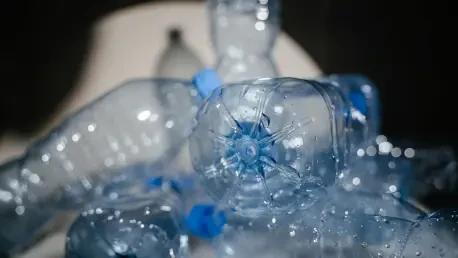In a world increasingly burdened by pollution, the challenge of cleaning contaminated water sources has never been more urgent, especially when it comes to pervasive plastic pollutants like Bisphenol A (BPA), which poses significant health risks. Researchers at the University of Glasgow in Scotland have developed a groundbreaking technology that harnesses ultrasound waves to tackle this pressing issue. By creating extreme conditions in water through sound waves, this innovative system can degrade harmful chemicals without additional substances, marking a potential turning point in environmental protection. This development not only addresses a critical gap in current water treatment methods but also opens the door to broader applications for combating pollution on a global scale. The implications of such a solution resonate deeply in an era where clean water is becoming a scarce resource, prompting curiosity about how this technology could reshape industrial practices and safeguard public health.
Breaking New Ground with Sonochemistry
Harnessing Sound Waves for Purification
The core of this revolutionary technology lies in the science of sonochemistry, which utilizes sound waves to trigger chemical reactions. The Glasgow research team, under the leadership of Professor Mark Symes, has engineered a dual-frequency ultrasound system that generates millions of tiny bubbles in contaminated water. These bubbles, when exposed to specific frequencies, expand and collapse rapidly, producing localized conditions of extreme heat and pressure. Such intense environments, comparable to extraordinary natural phenomena, effectively break down BPA molecules into harmless byproducts like carbon dioxide. Testing various frequency combinations, the researchers identified a pairing of 20 kHz and 37 kHz as the most effective, achieving a remarkable 94% degradation of BPA in just 40 minutes. This chemical-free approach stands out as a cleaner alternative to traditional methods, highlighting a significant leap forward in the quest for sustainable water treatment solutions.
Measuring Impact on Water Quality
Beyond simply removing pollutants, the ultrasound system demonstrates a profound impact on overall water quality. In addition to degrading a substantial portion of BPA, the technology reduces chemical oxygen demand—a key indicator of water purity—by 67% within the same short timeframe. This metric is crucial for assessing how much oxygen is needed to break down organic material in water, reflecting the level of contamination. The ability to improve this parameter without secondary waste production sets the system apart from conventional techniques like activated sludge or carbon absorption, which often transfer pollutants rather than destroy them. The efficiency of this method suggests potential for integration into existing water treatment infrastructures, providing a direct path to enhancing environmental safety. As industries grapple with stricter regulations on water discharge, such advancements offer a practical means to meet compliance while addressing public health concerns tied to chemical exposure.
Addressing Persistent Environmental Challenges
Tackling the BPA Threat Head-On
Bisphenol A, a chemical integral to plastic production with an annual output of approximately 10 billion kilograms, poses a severe threat due to its endocrine-disrupting properties. Accumulating in the human body over time, BPA is linked to serious health issues, including developmental problems in children and chronic conditions in adults. Traditional water treatment facilities often fall short in fully addressing this pollutant, merely removing it from water without breaking it down, thus leaving behind hazardous waste for further disposal. The ultrasound technology developed by the Glasgow team directly counters this limitation by obliterating BPA at a molecular level, ensuring no toxic residues remain. This approach not only mitigates immediate health risks but also reduces the environmental burden of managing contaminated byproducts, paving the way for a more sustainable cycle of water purification that prioritizes both ecological and human well-being.
Expanding Horizons for Pollution Control
Looking beyond BPA, the research team is exploring the potential of ultrasound technology to address other persistent pollutants, such as perfluoroalkyl substances (PFAs), often dubbed “forever chemicals” due to their resistance to degradation. The versatility of this method sparks optimism about its application to a wider array of contaminants that plague water systems worldwide. Collaborations with water treatment companies are already underway to test the system’s efficacy on an industrial scale, aiming to handle larger volumes of water than current laboratory prototypes allow. This scalability is critical for real-world implementation, especially in regions where industrial wastewater poses a significant challenge. Furthermore, the Symes Group’s prior work in using ultrasound to produce nitrate from air and water for agricultural purposes underscores the broader potential of sonochemistry to solve diverse global issues, from pollution control to food security, demonstrating a forward-thinking approach to environmental innovation.
Reflecting on a Sustainable Path Forward
Building on Past Successes
Looking back, the journey of the University of Glasgow’s research team in developing an ultrasound-based system to combat BPA contamination in water marked a significant milestone in environmental technology. Their success in degrading 94% of this harmful pollutant through sound wave-induced reactions showcased a viable, chemical-free alternative to outdated methods. The collaboration between experts like Shaun Fletcher and Dr. Lukman Yusuf highlighted a unified effort to address deficiencies in current water treatment infrastructures. By achieving substantial improvements in water quality metrics, the project set a benchmark for what innovative science could accomplish in the fight against pollution. This endeavor not only tackled an immediate problem but also laid a foundation for future explorations into sustainable practices that could benefit generations.
Envisioning Future Solutions
As the technology progressed, the focus shifted toward actionable next steps to ensure its impact reached beyond the lab. Scaling up the prototype to manage larger water volumes emerged as a priority, with ongoing discussions with industry partners to integrate the system into operational treatment plants. Exploring applications for other stubborn pollutants offered a promising avenue to broaden the technology’s reach, potentially transforming how environmental challenges are addressed globally. The vision of a cleaner, safer water supply drove continued research and adaptation, emphasizing the importance of innovation in safeguarding natural resources. This pioneering work served as a reminder of the power of scientific ingenuity to create lasting solutions, inspiring confidence in a future where technology and sustainability could coexist harmoniously.









